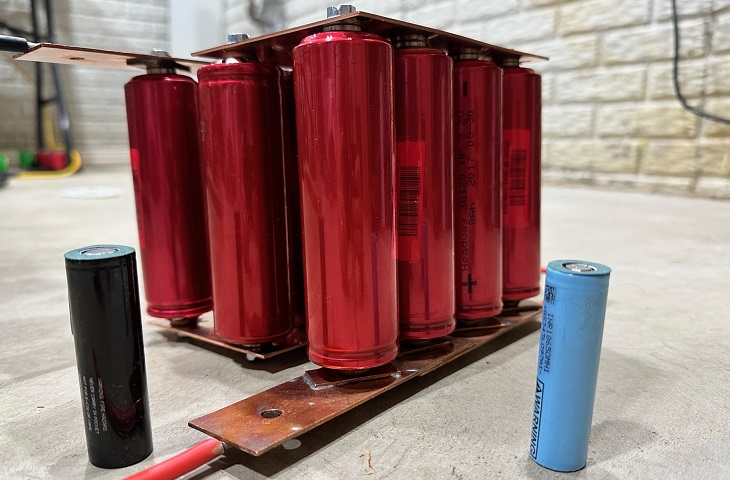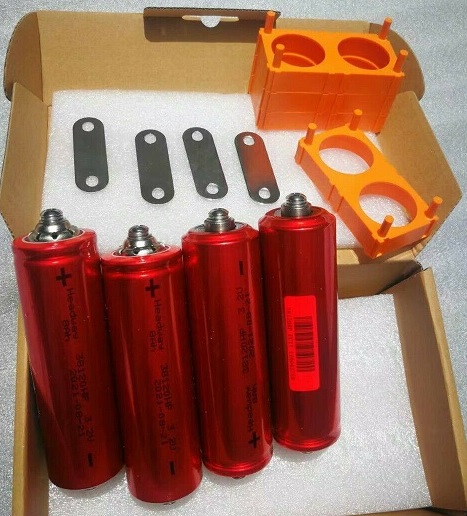
Differences Between 18650 vs 38120
18650 battery cells are commonly associated with NMC (Nickel Manganese Cobalt Oxide) chemistry, and 38120 battery cells are generally LFP (Lithium Iron Phosphate) chemistry. It's important to note that this isn't always the case. Compared to 18650 cells, 38120 cells can handle a lot more current. While it's true that 38120 cells commonly have capacities in the 8 to 9 amp-hour range, their size reduces their packing efficiency to the point where you will end up getting much more capacity using smaller 18650 cells.
18650 Vs. 38120 Chemistry and Construction
18650: NMC Chemistry and Construction
The 18650 battery, typically associated with NMC (Nickel Manganese Cobalt) chemistry, is a prevalent choice in numerous high-drain devices and applications, such as laptops, power tools, and electric vehicles. NMC batteries are celebrated for their high energy density, which allows them to store a substantial amount of energy in a relatively compact form. NMC chemistry cells have an extremely high packing efficiency, 3 of the highest capacity 18650 cells would have more capacity than the 38120 cell at about 1/3rd or the space.
This characteristic is particularly important in applications where space and weight are significant constraints. However, NMC chemistry is not perfect. One of its primary issues is thermal stability. Under extreme conditions, such as overcharging or high-temperature exposure, NMC batteries can present safety risks, including the potential for thermal runaway. This aspect necessitates careful management and protective measures to ensure safety in their use.
38120: LFP Chemistry and Construction
On the other hand, the 38120 battery is often linked with LFP (Lithium Iron Phosphate) chemistry. LFP batteries stand out for their exceptional robustness and inherent safety features. They are notably less susceptible to overheating and are characterized by higher thermal stability compared to their NMC counterparts.
This makes them an ideal choice in scenarios where battery failure or malfunction could lead to severe consequences. LFP batteries are particularly favored in applications that demand high levels of reliability and safety, such as in some medical devices, DIY powerwalls, and certain types of electric vehicles. Their resilience to temperature extremes and less reactive nature under stressful conditions contribute to their growing popularity in sectors where safety cannot be compromised.
White 38120 only indicates the size of the cell and not the chemistry or brand, it's important to consider the fact that a company called Headway almost exclusively uses this format. So, when someone says ‘Headway cells’ or ‘Headways’, they are talking about 38120 cells that use LFP chemistry.
One of the best things about Headway cells is the absolutely absurd amounts of current they can handle. These cells can do 120 amps each continuously and up to 240 amps for short amounts of time! This makes them favorable for uses like car audio battery banks, where there are large amounts of current outrush to power large amplifiers. They will also experience a large current inrush from the car alternator charging the battery bank.
18650 Vs. 38120 Assembly and Maintenance
18650: Welding Required
Assembling a battery pack with 18650 cells typically requires spot welding. This is because soldering can damage the cells due to the high heat involved. Spot welding ensures a reliable connection while minimizing the risk of damaging the battery.
38120: Simpler Assembly
The 38120, on the other hand, can be assembled using nuts and bolts, making them more accessible for DIY projects and easier to maintain. This feature is particularly advantageous for users who prefer to assemble and repair their own battery packs without specialized equipment.
18650 Vs. 38120 Performance Metrics
Capacity
When it comes to capacity, the 18650 and 38120 batteries have different offerings. The 18650 typically has a capacity range that can cater to high-drain devices. However, the actual capacity can vary based on the specific chemistry and design of the cell.
The 38120, while generally larger in volume than the 18650, does not always translate this into a proportionally higher capacity. This is largely due to the differences in the energy densities of NMC and LFP chemistries.
Current Capability
The current handling capability is where the 38120 really shines. LFP chemistry allows these cells to handle high current demands, making them ideal for applications like electric vehicles and large-scale energy storage, where rapid discharge and charging are common.
On the other hand, while 18650 cells can handle significant currents, they are typically outperformed by 38120 cells in this aspect. This limitation is partly due to the NMC chemistry and the cell's physical size.
Cycle Life
The cycle life of a battery is a critical factor in determining its long-term value and suitability for certain applications. LFP cells, like the 38120, generally offer a longer cycle life compared to NMC cells, like the 18650. This is because LFP chemistry is more stable over repeated charging and discharging cycles. It's not uncommon for LFP cells to last for thousands of cycles before their capacity significantly degrades. With both cell types and chemistries you can increase cycle life by employing some proactive measures.
In contrast, 18650 cells, although they offer a high initial capacity, tend to have a shorter cycle life degrading quicker over time. This means that over time, their ability to hold a charge diminishes faster compared to LFP cells.
38120 vs 18650 Closing Thoughts
When it comes to choosing between 38120 and 18650 batteries, the decision ultimately hinges on your specific needs. If you're prioritizing a compact and lightweight solution, 18650 batteries are the way to go. They offer a sleek and space-efficient design that's perfect for applications where every inch and ounce matter.
On the other hand, if you require high serviceability and the ability to handle substantial current loads, 38120 batteries are the better choice. These larger batteries offer the advantage of robust performance and can tackle demanding tasks with ease, making them the preferred option when space constraints are not a concern. So, the choice boils down to your specific requirements and priorities in power solutions.




